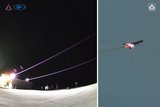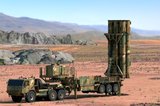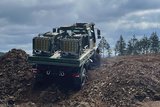KMW delivers first rocket launcher MARS II to German artillery school
In the presence of the vice president of the Federal Office for Defence Technology and Procurement, Reinhard Schütte, the artillery school in Idar Oberstein, Germany, received its first MARS II rocket launching system in the Guided Multiple-Launch Rocket System (GMLRS) edition. Krauss-Maffei Wegmann (KMW) thereby delivered a fully modernised combat system with an increased combat efficacy just 2¼ years after the signing of the pre-series-contract in December 2008.
"With the rocket launcher MARS II and the guided artillery rocket GMLRS UNITARY we now have an efficient means with the necessary precision and outstanding range, which finally allows us to complete the tasks assigned to us under almost any condition and that with the desired effect," said Brigadier General Heribert Hupka, commander of the artillery school and General of the artillery troops in Germany.
More than 2.300 implemented new parts, 300 metres of integrated wiring per vehicle for a fully electric drive and a quality inspection covering more than 450 hours per launching system are not only stand for a guaranteed sustainability, but also ensure an unmatched functionality and targeting precision on missions. The rocket launcher MARS II with the guided artillery rocket GMLRS UNITARY thereby offers a device that combines highest precision and maximum range. With the delivery of the first rocket launcher the schooling will commence immediately at the artillery school. After the completion of final tests within the scope of a field test the system is due for compliance testing next month at the White Sands Missile Range in the southern USA.
The rocket launcher MARS is in service with the artillery troop for over 25 years now. Conceptualised and optimised for the combating of large surface area targets under cold war circumstances, it was adapted to the considerably changed requirements of current as well as future threat scenarios and subsequently upgraded. Today, it takes effect on targets faster and more accurately than ever before - and will be an efficient partner in general or functional gunfights in future conflict scenarios within the framework of network-centric warfare.
Source: Krauss-Maffei Wegmann GmbH
More from Land Warfare
-
![Battlefield mobility, made in the UK]()
Battlefield mobility, made in the UK
How does Britain ensure that we can preserve the lives of our soldiers and allies – now and in the future – with homegrown innovation and resilient domestic manufacturing? At Pearson Engineering, we are proud to be a central part of the answer to this increasingly important question.
-
![First capability of Israel’s Iron Beam laser to be delivered by the end of December]()
First capability of Israel’s Iron Beam laser to be delivered by the end of December
Iron Beam is a family of high-energy laser weapon systems currently in development by Rafael Advanced Defense Systems and is designed to provide a low-cost kinetic effect against aerial threats at short distances.
-
![Hanwha awarded $482 million in major step for South Korea’s missile defence programme]()
Hanwha awarded $482 million in major step for South Korea’s missile defence programme
The deal to produce and supply launchers and missiles to South Korea follows a contract placed with Hanwha Systems last month for the manufacture of multi-function radars.
-
![Strengthening Baltic defence capabilities]()
Strengthening Baltic defence capabilities
How Latvia is bolstering its territorial defences, industrial capacity and international cooperation with Dynamit Nobel Defence’s SKORPION2 Remote Mining System.
-
![Land forces review: British Army vehicle programme stalls and company results land]()
Land forces review: British Army vehicle programme stalls and company results land
In the first monthly review of land forces stories, the Shephard team looks back to evaluate the major news events that have impacted the sector. The UK’s Land Mobility Programme was notable but another setback occurred when a market industry day was scrapped.























